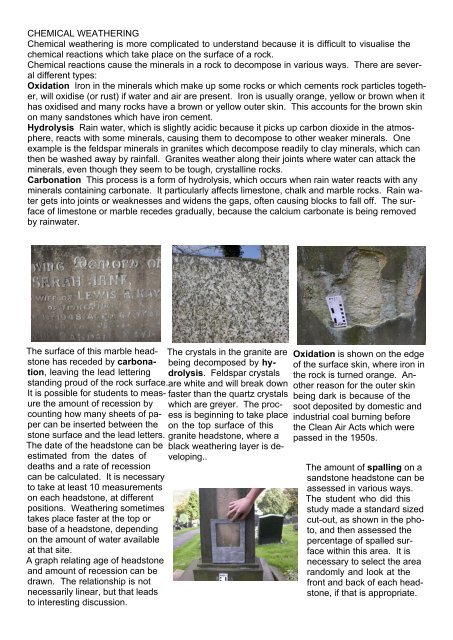Teaching weathering in West Yorkshire
Teaching weathering in West Yorkshire
Teaching weathering in West Yorkshire
Create successful ePaper yourself
Turn your PDF publications into a flip-book with our unique Google optimized e-Paper software.
CHEMICAL WEATHERING<br />
Chemical <strong>weather<strong>in</strong>g</strong> is more complicated to understand because it is difficult to visualise the<br />
chemical reactions which take place on the surface of a rock.<br />
Chemical reactions cause the m<strong>in</strong>erals <strong>in</strong> a rock to decompose <strong>in</strong> various ways. There are several<br />
different types:<br />
Oxidation Iron <strong>in</strong> the m<strong>in</strong>erals which make up some rocks or which cements rock particles together,<br />
will oxidise (or rust) if water and air are present. Iron is usually orange, yellow or brown when it<br />
has oxidised and many rocks have a brown or yellow outer sk<strong>in</strong>. This accounts for the brown sk<strong>in</strong><br />
on many sandstones which have iron cement.<br />
Hydrolysis Ra<strong>in</strong> water, which is slightly acidic because it picks up carbon dioxide <strong>in</strong> the atmosphere,<br />
reacts with some m<strong>in</strong>erals, caus<strong>in</strong>g them to decompose to other weaker m<strong>in</strong>erals. One<br />
example is the feldspar m<strong>in</strong>erals <strong>in</strong> granites which decompose readily to clay m<strong>in</strong>erals, which can<br />
then be washed away by ra<strong>in</strong>fall. Granites weather along their jo<strong>in</strong>ts where water can attack the<br />
m<strong>in</strong>erals, even though they seem to be tough, crystall<strong>in</strong>e rocks.<br />
Carbonation This process is a form of hydrolysis, which occurs when ra<strong>in</strong> water reacts with any<br />
m<strong>in</strong>erals conta<strong>in</strong><strong>in</strong>g carbonate. It particularly affects limestone, chalk and marble rocks. Ra<strong>in</strong> water<br />
gets <strong>in</strong>to jo<strong>in</strong>ts or weaknesses and widens the gaps, often caus<strong>in</strong>g blocks to fall off. The surface<br />
of limestone or marble recedes gradually, because the calcium carbonate is be<strong>in</strong>g removed<br />
by ra<strong>in</strong>water.<br />
The surface of this marble headstone<br />
has receded by carbonation,<br />
leav<strong>in</strong>g the lead letter<strong>in</strong>g<br />
stand<strong>in</strong>g proud of the rock surface.<br />
It is possible for students to measure<br />
the amount of recession by<br />
count<strong>in</strong>g how many sheets of paper<br />
can be <strong>in</strong>serted between the<br />
stone surface and the lead letters.<br />
The date of the headstone can be<br />
estimated from the dates of<br />
deaths and a rate of recession<br />
can be calculated. It is necessary<br />
to take at least 10 measurements<br />
on each headstone, at different<br />
positions. Weather<strong>in</strong>g sometimes<br />
takes place faster at the top or<br />
base of a headstone, depend<strong>in</strong>g<br />
on the amount of water available<br />
at that site.<br />
A graph relat<strong>in</strong>g age of headstone<br />
and amount of recession can be<br />
drawn. The relationship is not<br />
necessarily l<strong>in</strong>ear, but that leads<br />
to <strong>in</strong>terest<strong>in</strong>g discussion.<br />
The crystals <strong>in</strong> the granite are<br />
be<strong>in</strong>g decomposed by hydrolysis.<br />
Feldspar crystals<br />
are white and will break down<br />
faster than the quartz crystals<br />
which are greyer. The process<br />
is beg<strong>in</strong>n<strong>in</strong>g to take place<br />
on the top surface of this<br />
granite headstone, where a<br />
black <strong>weather<strong>in</strong>g</strong> layer is develop<strong>in</strong>g..<br />
Oxidation is shown on the edge<br />
of the surface sk<strong>in</strong>, where iron <strong>in</strong><br />
the rock is turned orange. Another<br />
reason for the outer sk<strong>in</strong><br />
be<strong>in</strong>g dark is because of the<br />
soot deposited by domestic and<br />
<strong>in</strong>dustrial coal burn<strong>in</strong>g before<br />
the Clean Air Acts which were<br />
passed <strong>in</strong> the 1950s.<br />
The amount of spall<strong>in</strong>g on a<br />
sandstone headstone can be<br />
assessed <strong>in</strong> various ways.<br />
The student who did this<br />
study made a standard sized<br />
cut-out, as shown <strong>in</strong> the photo,<br />
and then assessed the<br />
percentage of spalled surface<br />
with<strong>in</strong> this area. It is<br />
necessary to select the area<br />
randomly and look at the<br />
front and back of each headstone,<br />
if that is appropriate.


